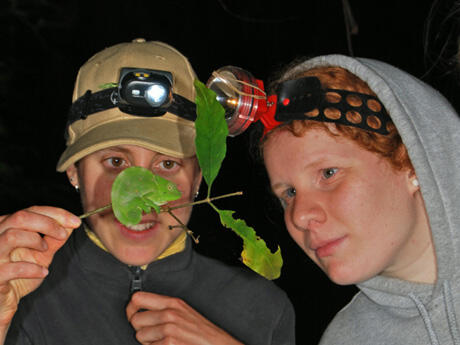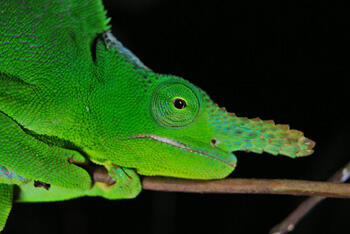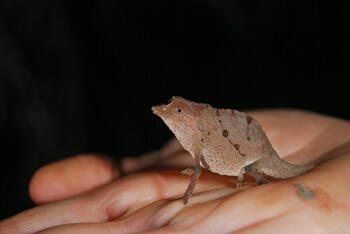Oct. 25, 2008
Undercover with the chameleon
VCU team to study reptile’s ecology in Tanzania
Share this story

Travel to the East Usambara Mountains of Tanzania and you’ll find a diverse collection of plant and animal life – many unique to that region alone. Among its inhabitants are a variety of chameleon species, thousands of which are exported each year for the pet trade.
Ecologists know little about the effects of harvesting on the viability of chameleon populations. James R. Vonesh, Ph.D., an assistant professor of biology at Virginia Commonwealth University, is leading an international team of researchers in the hopes of learning more about the basic biology and conservation and management of these unique reptiles. The work is funded by a grant from the National Geographic Society.
According to Vonesh, unsustainable harvesting by humans is a principal cause of vertebrate species declines and extinctions worldwide. The effects of harvesting are of particular concern in biodiversity hotspots such as the East Usambara Mountains of Tanzania, where forest patches with high species richness and endemicity are in areas heavily populated by humans.

Chameleons live throughout Africa, neighboring islands and parts of the Mediterranean. Worldwide, there are approximately 180 species or subspecies of chameleons. Many species have distinctive casqued heads with elaborate head ornaments, including horns or crests. They have large skin-covered eyes capable of moving independently of each other that allow them to keep a watchful eye for predators such as snakes and birds. The chameleon tongue is known for its length and ability to be projected rapidly to capture prey, primarily insects, at a distance. Its tail is often prehensile and acts as an additional limb for climbing. They also are popular pets.
“Our goal is to provide a preliminary evaluation of the sustainability of collecting wild chameleons for the pet trade to inform their conservation and management,” said Vonesh.
“This work is intended to enhance our understanding of the basic biology of chameleons and to provide data to aid the Tanzania Wildlife Research Institute and the Wildlife Division in setting sustainable harvest levels,” he explained. The work will be a combined effort between ecologists at American and Tanzanian universities and experts in wildlife trade in Tanzania.

Specifically, Vonesh and the team will examine the relationship between life history traits and basic population biology of chameleons endemic to the East Usambaras; geographic patterns of the socio-economic drivers of chameleon harvest within the East Usambara Mountains; and how current and projected harvesting rates of chameleons are likely to affect the long-term viability of these populations.
Work will begin next summer and involves a significant educational component.
“It is difficult to find funding for monitoring populations. In addition to the research conducted by a field team, we are coordinating with the Tropical Biology Association (TBA) to conduct annual surveys along long-term transects,” said Vonesh.
“TBA coordinates a graduate field course in tropical ecology and conservation based in the Usambaras. We’ll train the students in standard animal census techniques, and they’ll provide us with annual data on several focal populations,” he said.
Subscribe to VCU News
Subscribe to VCU News at newsletter.vcu.edu and receive a selection of stories, videos, photos, news clips and event listings in your inbox.










